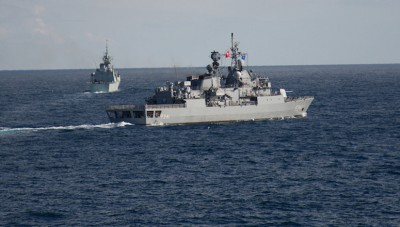NATO Increased Warship Presence in Black Sea by 33% Compared to 2019

By strengthening the presence of warships from non-Black Sea NATO members in the Black Sea, the military bloc is attempting to demonstrate its dominance in the region and the Alliance’s desire to neutralize and pressurize Russia’s influence in the area. Moscow’s Black Sea influence significantly increased after Crimea’s 2014 reunification with Russia. NATO’s military presence in the Black Sea is significantly strengthening, especially as warships in the area increased by 33% from January to September compared to the same period time last year. In 40% of cases, these ships are equipped with high-precision long-range weapons. This can be seen as a NATO attempt to intimidate Russia.
NATO is undeniably trying to put pressure on Russia by demonstrating its power. However, another important goal of the Alliance is to conduct intelligence operations against Crimea and Russia’s south. The Alliance is trying to locate Russian facilities, communication links, navigation systems, electronic warfare systems and other related military assets. There is of course the additional goal of training by simulating a battle with the Russian military.
After the reunification of Crimea, Russia gained a huge strategic advantage in the Black Sea region as it prevented NATO warships from being able to go to Sevastopol and turning it into a powerful pivot point that hypothetically could block Russia’s access to the Sea of Azov in the event of war. The Sea of Azov is critical to the security of Russia’s south as it is the beginning of the Volga–Don Canal.
Officially, the increased presence of NATO warships is in support of the Ukrainian navy. They are constantly participating in manoeuvres, such as the “Sea Breeze” exercises held in July. The number of military exercises is even growing. Countries far from the region, such as Canada and the Scandinavian states, are appearing in the Black Sea. Even this year, despite COVID-19 and all the restrictions, a large number of NATO warships arrived in the Black Sea. The last recorded case of non-Black Sea navy ships entering the Black Sea was recorded on Sunday when a British torpedo destroyer sailed in.
Warships of non-Black Sea countries can only be in the Black Sea for a limited time in accordance to the 1936 Montreux Convention. Therefore, that Convention is actually an obstacle for NATO today. Without this treaty, American and British warships could be permanently stationed in the Black Sea. The significance of this convention is based on guaranteeing the free passage of civilian ships through the Black Sea during peacetime and restricting the passage of warships of non-Black Sea states. According to the Convention, countries that do not go out to the Black Sea are not allowed to keep their ships in the Black Sea region for more than 21 days. In addition, there are restrictions when it comes to the tonnage and number of warships belonging to non-Black Sea countries – no more than 30,000 tons and nine ships. This means that no aircraft carrier can enter the Black Sea, since they weigh between 45,000 to 100,000 tons.
Also, according to the Montreux Convention, Turkey must not close access to and from the Black Sea via the Bosporus and the Dardanelle Straits during peacetime. During a war in which Turkey does not participate in, the sea must be closed to the passage of warships of any country participating in the war. Turkey, as a Black Sea state and member of NATO, can stay in the Black Sea as long as it wants and send as many ships as it wants, and has always participated in NATO Black Sea manoeuvres.
Although NATO countries do not recognize Russia’s sovereignty over Crimea, this does not correspond with the reality on the ground and they know that the Russian Black Sea Fleet is in a state of combat readiness and will respond to any threat. This increasing pressure in Black Sea also corresponds with pressure against Russia in the seas in the Arctic, the Baltics and the Pacific. The presence of NATO warships in the Black Sea is just a show of strength and it is highly unlikely that this will intimidate the Russian military in the region or make it withdraw from Crimea. For now NATO are respecting the 1936 Montreux Convention but this has not subsided any pressure that is being applied against Russia.
*
Note to readers: please click the share buttons above or below. Forward this article to your email lists. Crosspost on your blog site, internet forums. etc.
This article was originally published on InfoBrics.
Paul Antonopoulos is an independent geopolitical analyst.
Featured image is from InfoBrics

